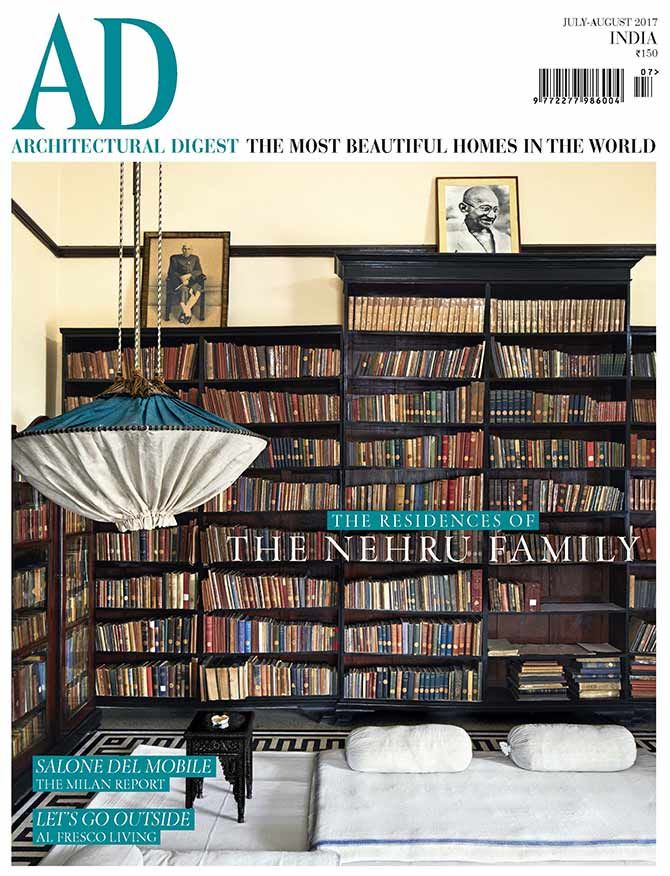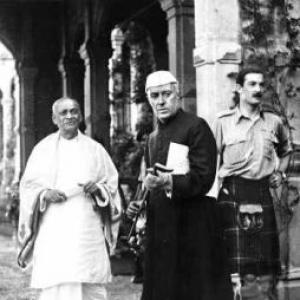A rare glimpse into Anand Bhavan and Swaraj Bhavan, where the seeds of Indian Independence were sown.
Kind courtesy: Architectural Digest India.
Ahead of the 70th anniversary of Independence, Architectural Digest India goes back to Allahabad, to Anand Bhavan and Swaraj Bhawan, where Jawaharlal Nehru and his family lived, iconic homes where the seeds of Indian Independence were sown and nurtured.
Conde Nast, Architectural Digest India's publisher, kindly shared photographs from the magazine's special feature on the homes where 'great events have happened and great decisions have been reached'.
All photographs: Simon Watson/Architectural Digest India July-August issue

Anand Bhavan (which translates to abode of happiness) was the Nehru family's principal home from 1929 until 1946, when Jawaharlal Nehru moved to New Delhi.
The Nehrus moved to this house from the older family home -- also called Anand Bhavan -- a few yards away.
Motilal Nehru, Jawaharlal's father and a leading lawyer in British India, renamed the older house Swaraj Bhavan (abode of freedom) when he donated it to the Indian National Congress in 1930.
With the launch of the Civil Disobedience Movement that year, nationalist leaders took momentous decisions, Congress workers thronged the corridors, fugitives hid out and the national flag was hoisted defiantly from its roof.
It was from here that patriarch Motilal, his children and grandchildren were led away, time and again, to prison.
In 1970, Indira Gandhi, then prime minister of India, handed over Anand Bhavan to a memorial trust.

More than any particular architect, the spirit behind the construction of Anand Bhavan was Motilal himself, who began building it in 1926 with such passionate attention to detail that after his death in 1931, his son called it another child of his, now 'lonely and deserted'.
Conservation architect Abha Narain Lambah suggests 'Swaraj (freedom) was on his (Motilal Nehru's) mind', when he chose an architectural idiom leaning towards Indian revivalism: Onion domes, decorative railings, jalis and rich internal embellishments such as the plasterwork on this stairwell.

Mahatma Gandhi stayed in this room when he visited Anand Bhavan.
The photograph on the wall (on the left) shows him standing on the verandah outside the room and greeting visitors below.
On the floor are some journals, a copy of the Bhagavad Gita, and a charkha, which became a potent symbol of Indian nationalism.

Gandhi first visited the Nehrus in 1919, radicalised their politics, and remained a towering presence in their lives.
This room where he stayed reflected his ascetic lifestyle, with its charpoy and khadi furnishings.

Two Nandi sculptures sit at the entrance to the central courtyard of Swaraj Bhavan.
It was a thoroughfare, a meeting place, and a venue for festivities that saw it festooned with decorations, and the tiered fountain at its centre filled with ice.
The wooden ladder at the top of the frame leads to a terrace, once popular for a view of the river Ganga.
This is now obscured by Allahabad's changing skyline, but staff say Sonia Gandhi invariably goes up to this terrace when she visits.

At the entrance of Anand Bhavan, a message is carved on the wall, which reads, 'This house is merely not a construction of bricks and mortar, rather it is closely related to our national struggle for freedom.'
'And within this house, many important decisions were taken and several great events took place.'
The original Anand Bhavan was sold to Motilal Nehru in 1898 against Rs 20,000.
After repairing the house with certain modifications, Motilal Nehru and his family entered the house in 1900.
Jawaharlal Nehru, future prime minister of India, was then about 11 years old.










